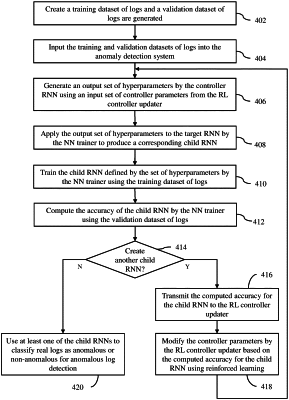| CPC G06N 3/08 (2013.01) [G06F 11/1476 (2013.01); G06N 3/006 (2013.01); G06N 3/044 (2023.01); G06N 3/045 (2023.01); G06N 3/088 (2013.01); G06N 3/082 (2013.01)] | 20 Claims |

|
15. A system for automatically generating recurrent neural networks for log anomaly detection, the system comprising:
memory; and
at least one processor configured to:
create a training dataset of logs and a validation dataset of logs, wherein the logs in the training and validation datasets relate to operations of at least one component running in a computing environment;
for each input set of controller parameters that is applied to a controller recurrent neural network:
generate an output set of hyperparameters at the controller recurrent neural network;
apply the output set of hyperparameters to a target recurrent neural network to produce a child recurrent neural network for log anomaly detection with an architecture that is defined by the output set of hyperparameters;
train the child recurrent neural network using the training dataset of logs to classify each of the logs as one of an anomalous log and a non-anomalous log; and
compute a log classification accuracy of the child recurrent neural network with respect to correct classification of anomalous logs and non-anomalous logs using the validation dataset of logs; and
using a current log classification accuracy of a corresponding child recurrent neural network, adjust at least one of the controller parameters used to generate the corresponding child recurrent neural network to produce a different input set of controller parameters to be applied to the controller recurrent neural network so that a different child recurrent neural network for log anomaly detection with a different architecture can be generated,
wherein the child recurrent neural network is a long short term memory (LSTM) recurrent neural network that includes first LSTM cells and wherein the controller recurrent neural network is a LSTM recurrent neural network that includes second LSTM cells.
|